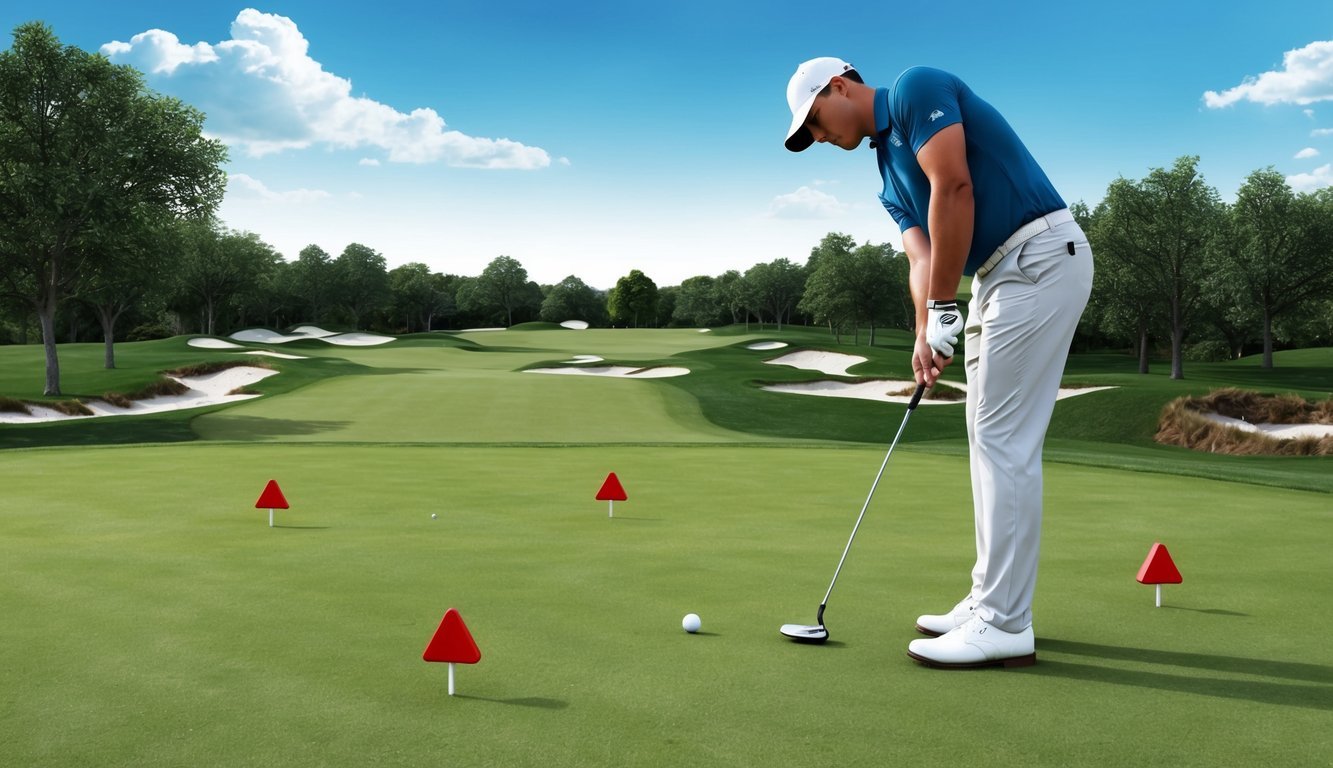Golf can seem overwhelming at first, but with a few key points, you can easily become more familiar with this classic sport.
Whether stepping onto the course for the first time or looking to refresh your memory, the essentials of golf revolve around simply playing the ball as it lies and maintaining an honest count of all strokes. For beginners, understanding the basic rules helps ensure a fair and enjoyable game.

Every golfer should be aware of certain rules and etiquette that guide player conduct on the course.
For instance, moving the ball by hand or foot for a better lie is strictly prohibited, maintaining the integrity of the game.
Familiarizing yourself with the course layout and rules such as positioning on the tee box can go a long way in getting started.
With the fundamentals in hand, you’ll not only improve your gameplay but also enhance your appreciation for the sport.
Observing proper etiquette, such as respecting other players’ turns and adhering to course-specific rules, fosters a respectful and enjoyable environment for all.
As you grow more comfortable with these aspects, you’ll gain confidence and skill on the fairways and greens.
Key Takeaways
- Beginners should know basic rules for fair play.
- Follow etiquette and respect course rules for a better experience.
- Observing rules boosts enjoyment and integrity of the game.
Essentials of Golf
Getting started with golf means understanding the key elements that form the foundation of the game.
This includes familiarizing yourself with the essential equipment used in play and gaining insight into the layout of a golf course.
Golf Equipment Overview
When you begin golfing, you’ll quickly learn that the choice and use of equipment are crucial.
A typical set includes various clubs: drivers, irons, and fairway woods.
Each type has a specific purpose.
For example, drivers are used for long-distance shots, while irons are typically used for mid-range hits.
You’ll also need a golf bag to carry your clubs. Golf balls are another essential; they vary in design and material to affect performance.
Don’t forget tees; these are small stands used to elevate the ball on the tee box for the initial stroke.
Ensure you have the appropriate gear to enhance your experience and skill.
Understanding the Golf Course
A golf course is composed of several distinct areas, each requiring different strategies.
The tee box is where play begins, and from there, your aim is to reach the green with the fewest strokes.
The fairway is the main path leading to the hole and typically offers the best surface for playing shots.
You’ll also encounter challenges such as bunkers (sand traps), rough (areas with longer grass), and hazards like water or dense vegetation.
Navigating through these obstacles requires strategic thinking.
The green is the most delicate part where a precise putt is essential to sink the ball into the hole.
Understanding these elements helps you approach the course with confidence.
The Basics of Play
Playing golf involves understanding the nuances of starting each hole and executing different types of shots.
From the moment you step up to the tee until you sink your putt, mastering these aspects makes the game enjoyable.
Teeing Off and Order of Play
When you’re ready to begin a hole, you’ll tee off from the tee box.
The order in which players hit is usually determined by a previous hole’s performance, with the lowest scorer going first.
Establishing a solid stance with your feet shoulder-width apart sets the stage for a great shot.
Use a driver for maximum distance, keeping your grip firm but relaxed.
While hitting the ball, aim for a balanced and smooth swing.
Focus on keeping your eye on the ball to ensure contact is made at the right spot.
Once the ball is in the air, observe its path to anticipate your next shot.
Remember, if your shot lands in a difficult spot like a bunker, it will affect the order of play for the next shot.
Common Shots and Techniques
During a round, you’ll come across various shots like full swings, chips, and putts.
For longer shots from the fairway, use a variety of clubs depending on the distance—fairway woods and irons are common choices.
For bunker shots, a sand wedge can help lift the ball out with ease.
When approaching the green, a putter becomes your go-to club, emphasizing precision and control.
Practice putting to gain better accuracy and feel.
Keep your movements smooth and controlled, especially when the ball is near the hole.
Understanding these common techniques and shots will boost your confidence and improve your game.
Rules and Penalties

Understanding the basic rules and penalties in golf is essential to enjoying the game and playing it correctly.
These rules cover how you interact with your surroundings and the types of play you’ll encounter.
Stroke Play and Match Play
In golf, you’ll encounter two primary types of play: stroke play and match play. Stroke play requires you to count every stroke on each hole over a round.
The player with the fewest total strokes wins.
If you commit a rules breach, you incur penalty strokes.
This includes situations like hitting the ball out of bounds or into a penalty area, often marked by red or yellow stakes.
Knowing the difference helps you strategize effectively throughout the game.
Match play, on the other hand, focuses on individual holes.
You strive to win more holes than your opponent.
Unlike stroke play, penalties impact only the current hole.
In both formats, the rule to play the ball as it lies is crucial.
You cannot improve your lie by moving objects or altering the environment, known as obstructions or impediments.
Each type of play has its own challenges and rewards, so understanding them can enhance your golfing experience.
Handling Obstructions and Interferences
During a game, various obstacles can interfere with play.
These include natural elements like trees and rocks or man-made structures such as sprinkler heads.
Some are considered movable obstructions and can be moved without penalty.
Meanwhile, immovable obstructions require that you take relief without penalty by dropping the ball within a certain distance from the object, maintaining the original line to the hole.
An unplayable lie occurs when your ball is in a position where it’s impractical to play it.
You can take relief by dropping the ball within two club-lengths, or behind the point where the ball lay, along a straight line extending back from the hole.
Knowing how to handle these situations ensures fair play and helps you avoid unnecessary penalties.
Understanding local rules from associations like the USGA also assists in navigating specific courses.
Scoring and Handicaps

Golf scoring involves recording the number of strokes taken per hole.
Handicaps allow players of different skill levels to compete more evenly by adjusting scores based on pre-established factors.
Recording Your Score
In golf, ensuring you correctly mark each stroke during a round is crucial.
A stroke is calculated every time you attempt to hit the ball, including missed swings.
Whether it’s getting the ball from the tee to the hole or playing on the fairway, each try counts.
A golf scorecard helps you track your performance across different holes.
It usually includes spaces to record each hole’s par, your strokes, and any penalties.
This structure aids in remembering specifics, such as how a shot played out on a challenging hole.
Be honest and diligent in noting every stroke.
Precise scorekeeping not only keeps the game fair but helps in evaluating how you can improve your performance.
Remember, every recorded stroke contributes to the round’s total score.
Understanding Handicaps
A handicap measures your potential ability compared to a scratch golfer.
It allows players with different skill levels to compete on equal terms.
This number is the difference between your average score and par, adjusted for course difficulty.
Handicap indexes make it easier to assess your skill level.
The calculation involves recent scores, course rating, and slope rating.
By establishing an index, you’re able to balance head-to-head competitions with more skilled golfers.
Having a handicap allows for meaningful improvements.
A lower index signals progress, motivating you to refine your game continually.
Understanding and maintaining your handicap can encourage friendly, competitive matches with fellow golfers.
Golf Etiquette and Player Conduct

Maintaining respect for the golf course and showing courtesy to fellow players is essential.
Good etiquette involves caring for the course and ensuring a pleasant game for everyone.
Let’s explore some key practices.
Respect for the Course
When playing golf, it’s important to treat the course with care.
Always repair divots using a divot tool to keep the grass in good shape.
Replace or fill divots with a mixture if provided by the course.
Keep pace with the group ahead to ensure an efficient game.
Staying on schedule keeps others from waiting.
If you’re falling behind, let faster groups play through.
When on the green, position your ball marker carefully.
Avoid stepping on someone else’s line to respect their opportunity for a clean putt.
Leave the flagstick as you found it, unless course rules suggest otherwise.
It’s considerate to use a towel to clean your shoes or equipment away from the green.
This maintains the course’s condition.
These small actions reflect respect not only for the course but also for the game itself.
Etiquette Towards Fellow Players
Showing courtesy to fellow golfers is a key component of player conduct.
Always arrive early for your tee time to avoid disrupting others who are ready to play.
This demonstrates respect and gives you time to warm up.
Avoid unnecessary noise and stay silent when others are taking their shots.
Practice swings should be taken away from other players to prevent any distractions.
Never hit more than one ball unless you’re practicing under appropriate conditions.
Keep track of your shots to prevent slowing down the game for others.
If you have lessons or are practicing, adhere to course etiquette during these times to ensure a pleasant experience for everyone.

